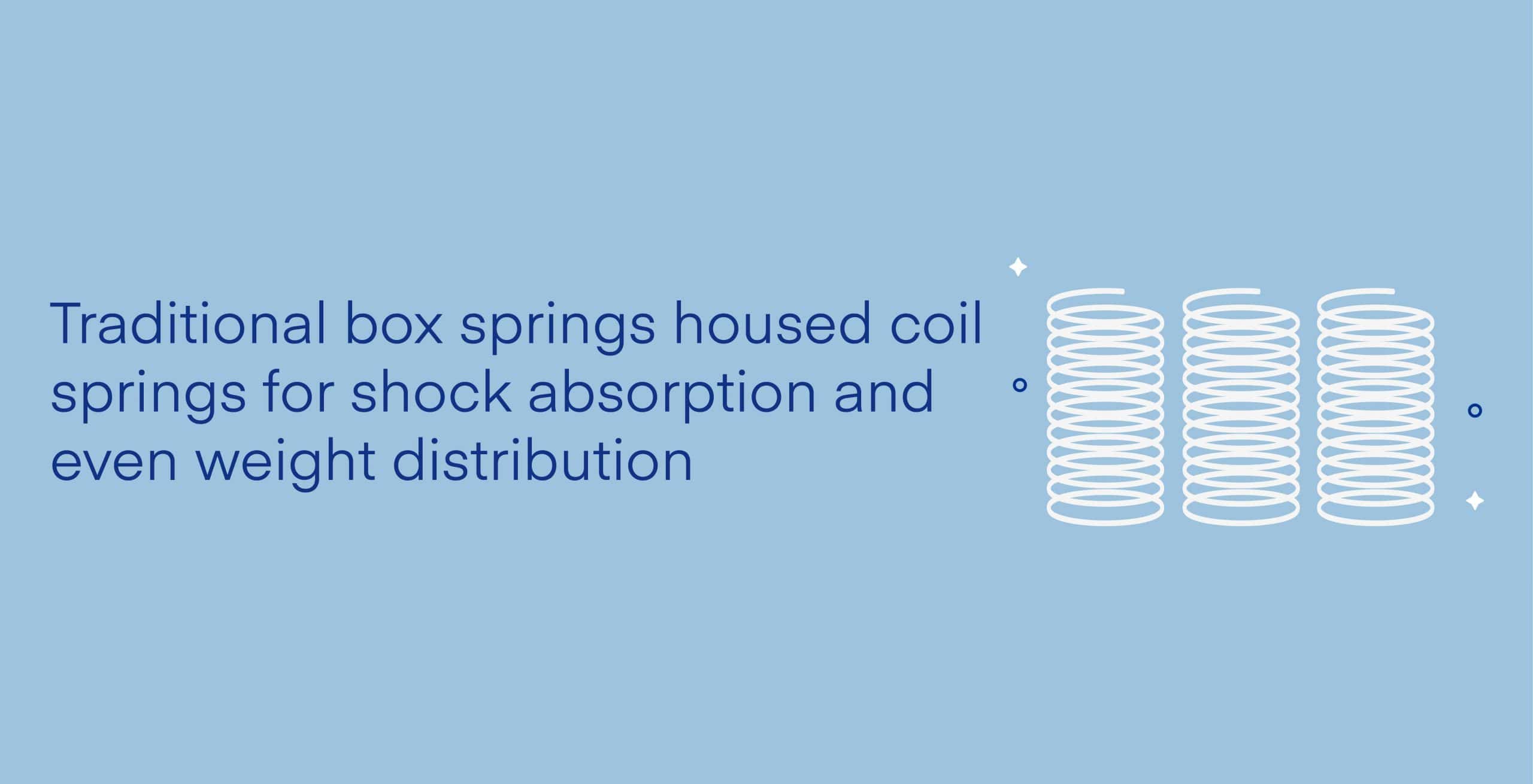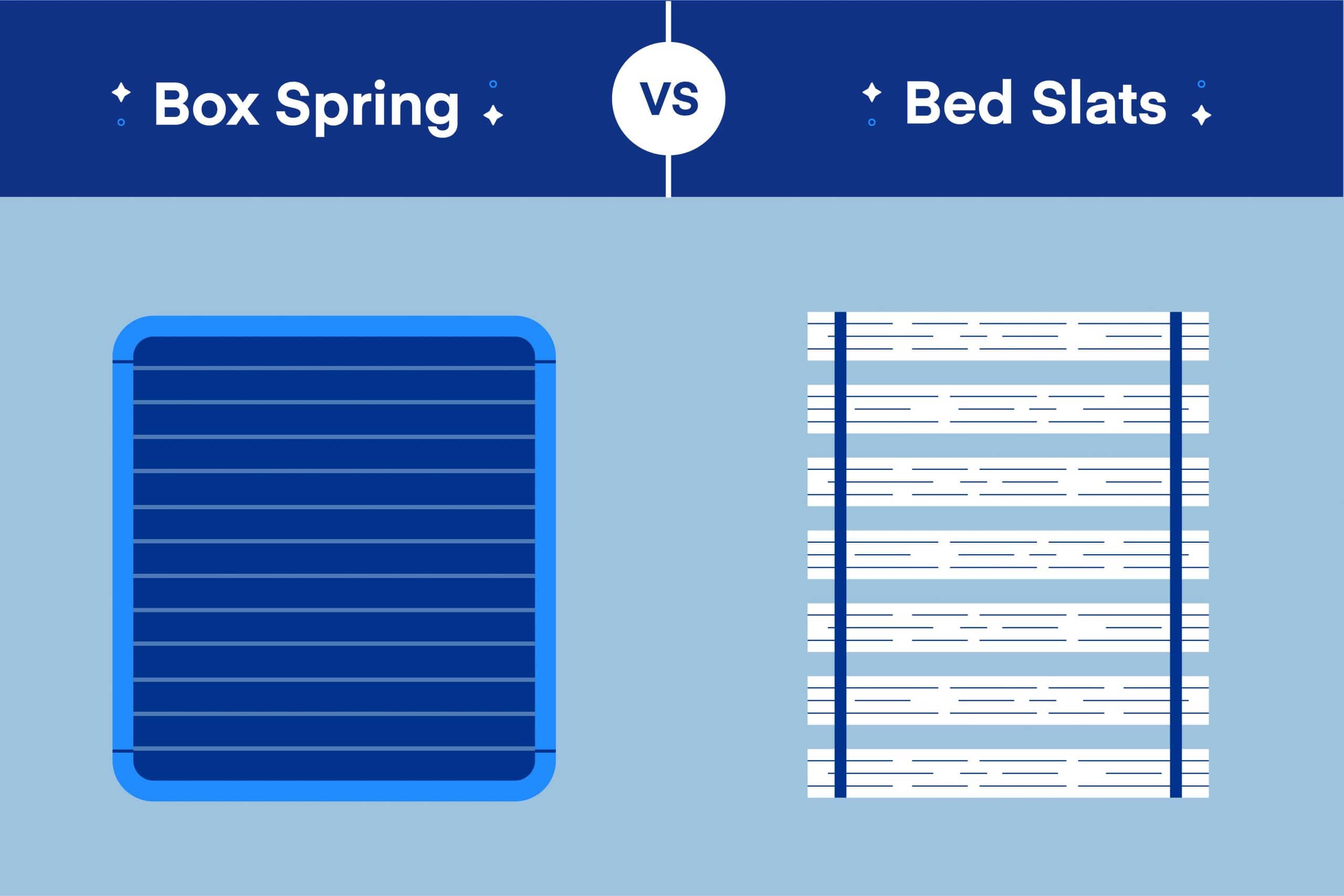No matter how comfortable a mattress is, it will not support you correctly if placed on the wrong foundation. If sagging and indentations develop, you may be forced to rest in uncomfortable sleep positions, causing pressure and tension to build up in the muscles, leaving you sore and stiff in the morning.
To get the best sleep possible, it is important to use the right foundation for your mattress. However, determining whether you need slats or a box spring is often difficult. To help, we outline the differences between these two types of foundations. Plus, we cover the pros and cons of each so you can decide which is right for you.
What Are Slats?
Bed slats are long planks typically made of solid wood or metal. Slats sit inside a mattress foundation or bed frame and are typically spaced 2 to 2.75 inches apart to support the mattress. They’re designed to keep body weight evenly distributed and prevent sinking.
Some bed frames have slats connected to one another, similar to a ladder. This style is often wrapped in fabric to keep slats together and prevent slipping. Other types of slats are not connected and rest side by side.
Both types of slats are secured to the side of the bed frame or foundation.
Best Slatted Surface: The Amerisleep Platform Bed
Quick Guide: A 30-Second Summary
| Best Platform Bed with Slats | Amerisleep Platform Bed |
| Best Mattress Foundation with Slats | Amerisleep Mattress Foundation |
-
Price Range
$399 to $599
-
Availability
All sizes
-
Warranty
1 Year
-
Height
13 Inches
Our Amerisleep Platform Bed relies on wide slats to maximize support and promote airflow through the bed.
- Extra-wide slats with minimal gaps between it
- Assembles within minutes
- Neutral bedroom fits in with most styles
- All sleeping positions
- People who own any type of mattress
- Hot sleepers
The side rails, center support, and slats of our Amerisleep Platform Bed are made of solid wood. The slats are oversized to minimize any unsupported gaps, while the half-inch high side rails keep the mattress from sliding.
This platform bed stands 13.5 inches tall. It gives any bedroom a modern look, with its neutral gray casing and clean corners.
Amerisleep’s Platform Bed is also incredibly easy to put together and requires no tools. It can support any mattress type, including memory and latex foam beds and hybrid mattresses.
Pros and Cons of Slats
Although slatted foundations have been available for many years, they have recently become a popular alternative to the standard box spring. Many people find bed frames with a slatted base to be more supportive, comfortable, and convenient. Below, we outline the pros and cons of slats.
Pros
- Affordable: Since slats have less material, they are more affordable than a standard box spring. If you purchase a bed frame with a slatted foundation where the slats are no more than 2.75 inches apart, there is typically no need to purchase a separate box spring. Most mattress types can rest directly on the slats.
- Durable: Most modern box springs are made of a wooden frame wrapped in fabric—they offer height but very little support. Slats are much more supportive and will ensure your mattress doesn’t sink or slide.
- Easy assembly: Wooden slats are lightweight and easy to disassemble, making them easier to move than heavy, cumbersome box springs.
- Airflow: On a slatted bed foundation, air circulates freely around the mattress. The open space prevents heat retention, allowing sleepers to remain cool throughout the night.
Cons
- Possible sagging: Slats spaced more than 2.75 inches apart could cause certain types of mattresses to sag. For example, memory foam mattresses should only be used with slats spaced no more than 2.75 inches apart.
- Possible shifting: If bed slats are not secured properly, they could move or fall during the night. This could lead to injury or damage to the mattress and bed frame.
What is a Box Spring?
Box springs are a metal or wooden box covered with fabric. They are sold separately from the mattress and the bed frame. Traditional box springs housed coil springs for shock absorption and even weight distribution. These springs were designed to push against the coils in the innerspring mattress above.

However, today, most box springs no longer have spring coils and are hollow inside instead. While conventional box springs were designed to support the mattress, most modern box springs simply provide height. Plus, as more modern mattresses become popular, box springs are no longer necessary for adequate support.
Pros and Cons of a Box Spring?
Although box springs are no longer as popular as slats, they are still useful, particularly if you have a pillow top or Euro top mattress with a traditional innerspring core. We outline the pros and cons of box springs to help you determine if they are right for you.
Pros
- Added height: Most bed frames with a slatted foundation have a low profile look. For those who prefer a higher bed, a box spring can be used to elevate the mattress.
- Possible bounce: If the box spring has spring coils, it will provide a slight bounce when paired with an innerspring mattress. However, not all box springs have coils. If a bouncy quality is important to you, be sure to keep this feature in mind when shopping.
Cons
- Difficult to move: Most box springs do not collapse or break down for transportation, making them awkward and difficult to move.
- Heavy: Some bed frames may not support the weight of a box spring, mattress, and sleeper, resulting in damage to the bed frame and mattress.
- Lack of support: Box springs without spring coils provide very little in terms of support. The perimeter of the mattress may be supported, while the middle is not. This could result in sagging and indentions, especially for a mattress with a foam base.
Frequently Asked Questions
How long are slats for a twin bed?
A twin mattress measures 38 inches wide. Therefore, the slats for a twin size bed frame should measure between 40 to 44 inches long. The extra 2 to 3 inches on each side allows for bedding and ensures the mattress does not fit too snugly on the frame.
Can I use plywood instead of a box spring?
Depending on the type of mattress you have, slats may need to be spaced no more than 2.75 inches apart. For example, memory foam beds may sag and become damaged if slats are too far apart. If your bed frame has wide slats, you can place a 1-inch piece of moisture-resistant plywood on top of the slats to support your mattress and prevent sinking.
A bunkie board serves a similar purpose. These boards are typically 1 to 3 inches thick and made of wood, plywood, or particleboard. Bunkie boards sit beneath your mattress and are designed to provide a stable, supportive base no matter what type of bed frame or foundation your mattress rests on.
How much weight can bed slats hold?
Most modern bed frames with a slatted foundation provide sufficient support for up to 600 lbs. However, some are designed to hold no more than 300 pounds, so be sure to verify the manufacturer’s weight limit before purchasing.
Is it bad to put a mattress on the floor?
Placing your mattress on the floor may provide firm support. However, most experts don’t recommend placing it directly on the ground since this can cause dust, dirt, and bacteria to collect in the mattress.
If you live in a humid climate, moisture can accumulate and lead to mold and mildew. This is especially true if you have hardwood floors or if your bedroom is in a damp environment like a basement. Over time, exposure to these contaminants can lead to serious health issues.
How many bed slats do I need for a full size bed?
Full size mattresses also referred to as double beds, are 54 inches wide. Slats on most full size bed frames will be between 56 to 60 inches long. Most slats are roughly 2 to 6 inches longer than the mattress itself.
Conclusion
Bringing home a new mattress is exciting. It is a chance for you to find deeper, more restful sleep. However, if you pair it with the incorrect bed foundation, it may not stay comfortable for long.
An unsupportive base can cause sagging and sinking, leading to spinal misalignment, sleep disruptions, and morning aches and pains. While a box spring may be suitable for some mattress types, slats are much more versatile, supportive, affordable, and convenient.
About the author
McKenzie Hyde is a Certified Sleep Science Coach and a full-time writer specializing in sleep health and the mattress industry. With a Master of Arts degree in literature and writing from Utah State University, McKenzie combines her passion for writing with her in-depth knowledge of sleep science. Her articles cover a wide range of topics, including best sleep practices for students, the consequences of sleep deprivation, and choosing the right mattress for back pain relief. McKenzie's dedication to delivering accurate and informative content makes her a valuable contributor to the field of sleep health.
View all posts






